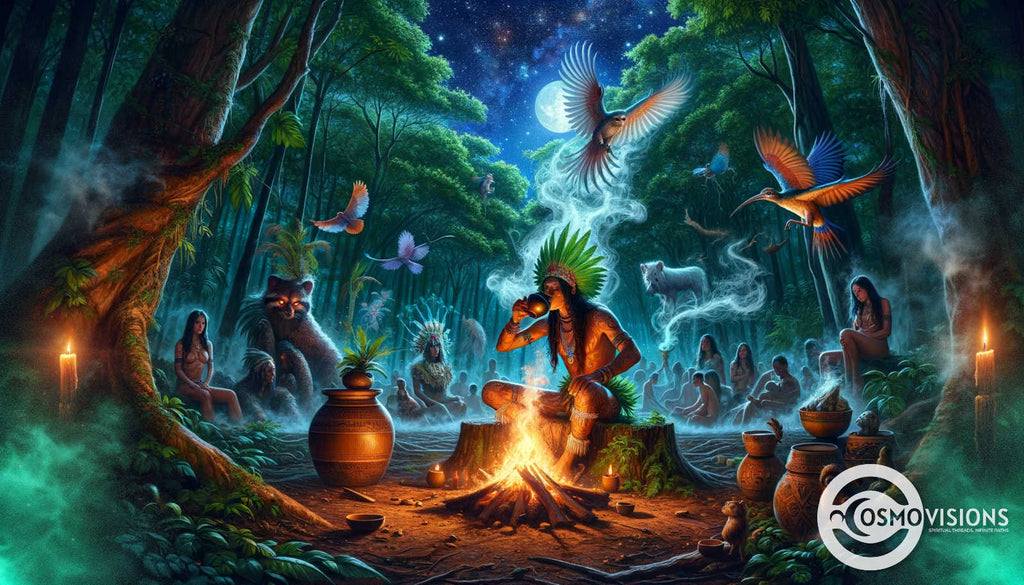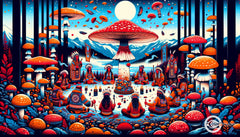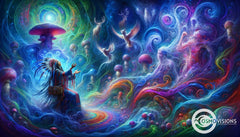Ayahuasca: The Sacred Brew of the Amazon
Posted by Massimiliano Geraci

Deep in the lush Amazon rainforest grows a vine that has captured imaginations and served as a conduit to the spirit world for countless generations. This mystical liana is known broadly as ayahuasca, though it answers to many names among the indigenous tribes who prepare it as a sacred divination brew. More than a plant, ayahuasca has become an anchor intricately intertwined with numerous Amazonian societies' cosmology, rituals, and identity.
Ayahuasca and Yagé – The Vine and the Leaves
Unlike other visionary plant concoctions, ayahuasca features not one but two primary botanical ingredients that work synergistically to produce its psychoactive effects when consumed orally.
The first, essential component comes from the woody ayahuasca vine, Banisteriopsis caapi, which grows abundantly across the Amazon basin. A tangle of brown vines clinging tightly to the towering trees of the rainforest, B. caapi stands out with its curious bark and twining habit. The bark, when cut oozes a blood-red serum, echoing ayahuasca’s moniker as the “vine of the dead” in Quechua and other languages. To prepare the brew, vines are beaten with wooden mallets to break into fibrous strands, boiled in water over many hours to release their potent alkaloids. Among these are the ß-carboline compounds harmine, tetrahydroharmine, and harmaline, collectively known as MAO inhibitors.
The second ingredient is most commonly the leaves of the jungle shrub Psychotria viridis, known widely as chacruna, though the related woody vine Diplopterys cabrerana may be substituted in certain regions. Unlike the B. caapi, these leafy additives contain the hallucinogenic alkaloid N,N-dimethyltryptamine, or DMT. Though extremely psychoactive when insufflated or injected, DMT produces negligible effects when ingested orally, due to enzymatic breakdown in the stomach. Herein lies the biochemical magic of ayahuasca – the ß-carboline alkaloids in the vine deactivate these digestive monoamine oxidase (MAO) enzymes, allowing the DMT from the leaves to be absorbed systemically. The result is the unique visionary experience for which ayahuasca has been treasured for centuries.

Widespread Use, Diverse Names
Ayahuasca enjoys extensive use among indigenous cultures across the Upper Amazon basin, from tribes along the Putumayo River of Colombia to Cashinahua settlements in southwestern Brazil. This broad diffusion means the brew goes by an array of names reflecting the region's linguistic diversity. The terms ayahuasca and yagé are emblematic of the two primary plant pairings - with chacruna leaves and Diplopterys leaves, respectively.
Ayahuasca stems from the Quechua, which it translates to “vine of the souls” or “vine of the dead”, suggesting its shamanic use in accessing knowledge from spirits and deceased ancestors. Yagé is the sacred brew as known by various tribes in Colombia, including the Siona along the Putumayo River. Both names have gained global recognition and may be used interchangeably by outsiders, though purists consider the choice of the term significant based on leaf additive. Beyond these two foremost designations, every tribe has crafted its name for B. caapi in their unique language - nixi pae for the Huni Kuin of Brazil, kamarampi among Peruvian Matsigenka peoples, pilde by the Emberá in Colombia, and so on. Some terms refer to the vine, while others describe the complete psychoactive decoction.
Despite such diversity of names and languages, the use of ayahuasca/yagé cuts across ethnic boundaries, becoming perhaps the quintessential Amazonian means of engaging the supernatural realm - the conduit par excellence for speaking with spirits, diagnosing and healing illnesses, and securing magic for the hunt or other tribal aims.
Ayahuasca in Traditional Cultures
Far more than a psychoactive plant concoction, ayahuasca assumes an integral role in the cosmology and ontology of numerous indigenous societies across the Upper Amazon. Access to the sacred brew provides critical spiritual insights, healing wisdom, and magic used in sustaining tribal ways of life.
Communication with the Spirit World
In native Amazonian worldviews, an idyllic primordial era exists where animals speak, spirits and humans freely interact, and nature is boundless in abundance. This Edenic paradise faded for humans due to some tragic twist of fate or trickery by jealous spirit beings. Ayahuasca offers a glimpse of this mythical age, temporarily parting the veil to reveal the enchanted, parallel spirit universe still thriving alongside our mundane human existence.
The brew facilitates dialogue with the supernatural denizens of this magical plane, who guide maintaining cosmic and societal balance. Shamans regulate their communities’ relationship to the spirit world, gaining specialized knowledge from plant teachers and animal spirits contacted via ayahuasca visions. These healing, hunting, farming, building, and other insights are then disseminated, perpetuating tribal traditions.
For the Piaroa of Venezuela, key figures called “owners of songs” ingest yopo powder nightly to convene with spirits, intoning intricate melodies learned from plant allies to cure illnesses plaguing their village. The validity of this defense magic relies entirely on the visions and lessons transmitted from yopo’s tryptamine alkaloids. Should the ceremonial leaders err in remembering verses or become lax in their diligent schedule, they believe failing cosmic support exposes their people to harm.
Ayahuasca likewise enables direct access to the realm beyond through manned shamanic flights. Matsigenka shamans partaking of the kamarampi brew find their souls hosted in glittering cloud forests by saangarite spirits, who dwell behind perceived clearings in real-world thickets. The saangarite in turn visit the shaman’s body back in the material village, providing healing or defensive magic to attending tribespeople.
The reciprocal exchange reflects quasi-dualistic beliefs around skilled shamans and their personal spirit familiars occupying interconnected planes temporarily melded by the vine decoction. Knowledge and power flow back in successfully navigating these depths, benefiting human charges under the shaman’s care.
Hunting Magic and Other Purposes
In addition to divination and healing, Amazonian tribes rely on ayahuasca’s magic for more practical tribal aims like boosting hunters’ success in capturing wild game. Among the Asháninka people, shamans ingest ayahuasca then morph into hummingbirds, flying to the spirit lords of jungle animals to request prey animals for the village. For the A’i tribe, ayahuasca allows the shaman’s detached soul to visit animal masters in their celestial homes, securing promises of future bounty and directing hunters to locations where this quarry will appear. Hunters typically repay the shaman with choice portions of any catch thanks to such spiritual intercession.
The importance of ayahuasca magic also extends to securing positive outcomes in tribal skirmishes with enemies, blessing planting and harvesting crops, and various other purposes bound up in the Amazonian peoples’ rich spiritual existence.
Importance of Songs in Guiding Visions
Ceremonial chanting, singing, and whistling frequently accompany ayahuasca use, helping direct the unfolding visionary experience. With Huni Kuin groups, lively song exchanges occur during collective drinking sessions, where participants even accuse singers of punishing wrongdoers or playing tricks by making spectral snakes overly long!
Shamans can engineer shared visions for attendees by detailing beforehand what images will come and what they signify. The Siona hold that early after drinking yagé, shamans first glimpse certain abstract motifs and colors based on songs sung, as if accessing a universal visionary language. The symbols make sense based on meanings encoded in tribal myths - they are a portal to communicating with spirits. Indeed, with talented singing guiding experiences, entire rooms perceive the same visions.
This intimate linkage between music and drug experience holds across indigenous Amazonian healers. Tukano shamans pass down songs called wai , which summon or dismiss spirits, while Shipibo icaros similarly shape visions by lyrically describing the designs soon to appear. Rhythmic qualities of the melodies and chants enable trancing participants to “move together” through shared mental phenomena.

Roles and Restrictions
Norms for consuming ayahuasca diverge across Amazonian societies from reserved exclusively for elder male shamans to large communal participatory events open equally to all village members. Taboos around female participation, especially concerning menstruating women, also vary between flexible and strict.
The Asháninka exhibit one of the more permissive stances on gender and age inclusiveness regarding the kamarámpi, their term for ayahuasca. Women play prominent roles in learning alongside men during community healing sessions led by a senior shaman. Gender parity breaks down among the formally-initiated shamans as cultural norms favor male practitioners.
Compare such relative egalitarianism to tribes like the Huni Kuin, where solitary village shamans once administered nixi pae while female involvement has waned over generations. Common reasoning across indigenous groups cites the spiritual pollution and contamination believed to be induced by menstrual blood. Exposing powerful plant spirits to such impurities risks souring the potency of ayahuasca stored by the shaman.
Though elder women often face less exclusion given the absence of menstruation, the link between femininity and spiritual uncleanliness permeates many facets of Amazonian cultures in varying degrees. Indeed, Yagua tribes only grudgingly accept postmenopausal female shamans, who invariably must refrain from any visionary plant use should they become pregnant.
Interestingly, early ethnographic accounts suggest a more prominent role for women preparing and partaking of ayahuasca among groups like the Huni Kuin. Stories of mythic heroines wielding the brew likewise bolster theories that erosion of female spiritual authority occurred relatively recently compared to documented traditions extending back centuries. Like dynamics around magic plants worldwide, Amazonian tribes’ policies limiting women’s powers gradually solidified out of an amalgam of factors – though threads of influence from Western religious norms and prejudices imported by missionaries seem especially likely.
Mythological Themes
Creation stories and cultural lore around ayahuasca provide a window into indigenous belief systems and values while explaining the sacred brew’s origins. The main subjects of the rich oral storytelling tradition include how people first used and learned from the vine, its deep ties to shamanic knowledge, and its role in letting shamans access otherworldly domains.
Origins and Cultural Transmission
Myths commonly trace ayahuasca to the primordial times of early human-animal-spirit cohabitation in the Amazon. The brew often represents a gift passed from divine beings, cultural heroes, respected elders, or shape-shifting forest people in line with native conceptions of fluid identity. These benefactors bestow the vine decoction upon shamans or aspiring healers, who then pass down proper preparatory knowledge throughout their tribe.
Anaconda spirits first revealed the ayahuasca recipe in mystical encounters with the Bora people. Desana tales in Colombia recount the divine Grandmother Ayahuasquera, who swallowed the brew while pregnant, giving traumatic (spiritual) birth to the woody Banisteriopsis vine itself! This story echoes symbolic motifs of drugs entering and altering bodies, as when Asháninka accounts tell of ancestral shamans manifesting ayahuasca vines from their very fingers.
Across lowland societies, the sacred brew forms the cornerstone of traditional health and spiritual practices — yet the shamanic quest to acquire such knowledge never ends. Indeed, Matsigenka healers on spiritual journeys learn new plant medicines and cultivation techniques from the saangarite spirit hosts in exchange for treating their human kin.
Ascent to the Heavens
A recurring theme across ayahuasca traditions involves tribal members or whole villages ascending to the celestial realm of spirits and mythic beings by taking the sacred brew. The metaphysical flights demonstrate the vine’s power in raising human souls toward cosmic understanding, though they often end tragically due to greed, haste, or trickery.
Multiple versions occur among rainforest Panoan language speakers. In one account, ancestors urge their neighbors to quickly gather atop their lifted homes before all float up to paradise. But a wayward messenger loses precious time dallying with women and returns too late for his village to climb the ascending structure, condemning them to earthly woes.
Indeed, multiple South American tribal beliefs hold that properly prepared or concentrated ayahuasca bestows elevated consciousness, allowing levitation. Sadly, imperfect preparation or dilution of potency keeps aspirants frustratingly earthbound. Still, a shared eschatology perceives ayahuasca as permitting the transcendence of mortal limits toward planes where humans once freely mingled with spirits as equals.
Mother Ayahuasca
No myth better encapsulates ayahuasca’s divine embodiment in native consciousness than the sacramental drama of Lady Ayahuasca among rainforest Tukanoan groups. In a cosmic time before people, Anaconda ancestor spirits deposit the first men without mates in an empty maloca longhouse. From the endless sky descends a resplendent woman — the mother of the yagé vine herself! — who holds the secrets of sexuality and eating bitter yagé, bestowing transformative knowledge onto humanity.
When Lady Ayahuasca begins struggling with labor pains, tribesmen gather to witness the miraculous birth of the sacred Banisteriopsis woody vine from the maiden’s womb. They lovingly cut the baby liana into pieces, carrying the parts to adopted “fathers” of different ethnicities, recognizing their shared heritage through the beloved mother of the vine.
The myth poetically conveys ayahuasca’s generative essence through feminine personification while cementing tribal identities tied to the collective ancestry symbolized by Mother Ayahuasca’s coils. Like an umbilical cord to primordial wisdom binding far-flung cultures, ayahuasca remains the beloved teacher from whom all may drink and find communion.






















